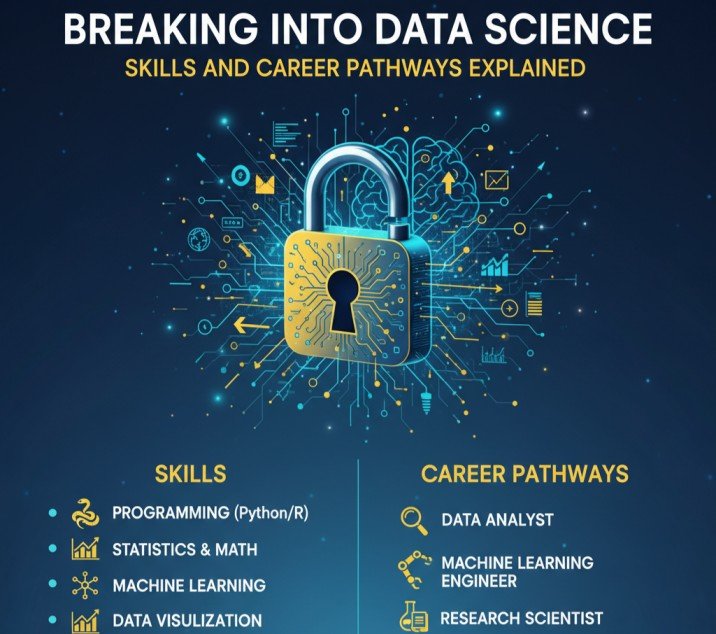The field of data science is booming, offering exciting opportunities for professionals passionate about solving complex problems and deriving insights from data. As organizations increasingly rely on data-driven decision-making, the demand for skilled data scientists is skyrocketing.
If you’re considering a career in data science, understanding the essential skills and the diverse career pathways is crucial. This article breaks down everything you need to know to kickstart your journey into the world of data science.
Why Choose Data Science?
Data science is more than just a trend—it’s a transformative field that plays a pivotal role in shaping industries. Businesses leverage big data to predict trends, optimize operations, and deliver personalized experiences. This reliance on data creates a growing need for professionals who can harness its potential.
Key reasons to pursue a career in data science:
- High Demand: The demand for data scientists far exceeds the supply, ensuring lucrative opportunities.
- Versatile Applications: Data science is used in diverse industries, from healthcare to finance and e-commerce.
- Competitive Salaries: Data science professionals are among the highest-paid in the tech industry.
Essential Skills for Data Scientists
To break into data science, you’ll need a blend of technical expertise and analytical thinking. Below are the core skills required to thrive in this field:
1. Programming Skills
Proficiency in programming languages like Python and R is essential for data cleaning, analysis, and building machine learning models.
- Python: Widely used for its simplicity and powerful libraries like Pandas, NumPy, and Scikit-learn.
- R: Ideal for statistical computing and data visualization.
2. Data Analysis and Visualization
Understanding data is at the heart of data science. You should know how to analyze datasets and communicate findings effectively using visualization tools like:
- Tableau: For interactive dashboards.
- Matplotlib and Seaborn: For creating insightful graphs in Python.
3. Mathematics and Statistics
A solid grasp of mathematics, especially linear algebra, calculus, and probability, is essential for developing models and interpreting data.
4. Machine Learning
Knowledge of machine learning algorithms, including regression, classification, clustering, and deep learning, is crucial for predictive analysis. Popular frameworks include:
- TensorFlow
- PyTorch
5. Big Data Tools
Familiarity with big data technologies like Apache Hadoop, Spark, and SQL helps manage and process large datasets efficiently.
6. Soft Skills
- Problem-Solving: The ability to approach challenges analytically.
- Communication: Explaining technical insights to non-technical stakeholders is vital.
Steps to Start Your Data Science Career
- Learn the Basics
Start with foundational courses in Python, statistics, and data analysis. Platforms like Coursera, edX, and Udemy offer excellent beginner-friendly courses. - Build a Portfolio
Work on real-world projects to showcase your skills. For example, analyze datasets from platforms like Kaggle and create visualizations or predictive models. - Earn Certifications
Certifications like Google’s Data Analytics Certificate or Microsoft’s Certified: Azure Data Scientist Associate can validate your expertise. - Gain Hands-On Experience
Look for internships or freelance opportunities to work on real data science problems. Practical experience is invaluable. - Network and Stay Updated
Join data science communities on platforms like LinkedIn or attend industry conferences to network with professionals and learn about the latest trends.
Career Pathways in Data Science
The versatility of data science opens doors to various career paths. Here are some prominent roles:
1. Data Scientist
- Responsibilities: Analyzing large datasets, building machine learning models, and deriving actionable insights.
- Skills Needed: Python, machine learning, and statistical analysis.
2. Data Analyst
- Responsibilities: Interpreting data, creating visualizations, and supporting decision-making processes.
- Skills Needed: SQL, Tableau, and Excel.
3. Machine Learning Engineer
- Responsibilities: Designing and deploying machine learning systems.
- Skills Needed: Deep learning frameworks like TensorFlow and cloud platforms like AWS.
4. Business Intelligence Analyst
- Responsibilities: Translating data into business insights to inform strategies.
- Skills Needed: Power BI, data visualization, and domain knowledge.
5. Data Engineer
- Responsibilities: Developing systems for collecting, storing, and processing large datasets.
- Skills Needed: Big data tools like Hadoop and Spark, along with programming in Python or Java.
Challenges in Data Science
While data science is rewarding, it comes with challenges:
- Rapidly Evolving Field: Staying updated with new tools and techniques is essential.
- Data Privacy Concerns: Ethical considerations are critical when handling sensitive information.
- Complex Problem-Solving: Real-world problems often require innovative solutions.
Conclusion
Breaking into data science requires dedication, continuous learning, and hands-on experience. By mastering the essential skills and exploring diverse career pathways, you can position yourself as a valuable asset in this fast-growing field.
With businesses increasingly relying on big data for decision-making, now is the perfect time to embark on your data science journey. Equip yourself with the right skills, build a strong portfolio, and leverage networking opportunities to unlock a fulfilling career in data science.
Start today, and let your passion for data shape the future!









